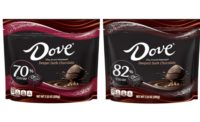The release of a new Star Wars movie seems to be affecting craft chocolate makers. Dark bars with a “force” factor above 80 percent cacao abounded at last week’s Winter Fancy Foods Show at the Moscone Center in San Francisco. Intense chocolate, as well as reimagined marshmallow and marzipan bonbons and innovative plantain-based snacks topped the candy and snack trends spotted at this 41st annual winter show.
With 80,000 specialty food and beverages on display and halls packed with 20,000 attendees — a 16 percent increase from last year, which represented the show’s strongest attendance — the options to see and savor proved galactic. But it was impossible to ignore the appearance of so much intense dark chocolate. So, what’s fueling their presence?
“It’s the health and wellness segment; chocolate consumers wanting their chocolate indulgence but with less refined sugar,” explains Taza Chocolate’s founder and chocolate maker Alex Whitmore. It’s not all about product benefits, however, for when the bars are formulated properly, “they can really sing in your mouth.”
And sing they did, appearing in a number of creative apparitions, such as single-origin, interesting inclusions and re-imagined formulations, such as olive oil swapping out cocoa butter.
Such product innovation and demand for healthier sweets has driven up dark chocolate sales by 9 percent, reported the National Confectioners Association (NCA) earlier this month. “But even within dark chocolate, the market is slowly shifting from dark to darker: 57 percent of shoppers said they will shift up to a higher cocoa percentage when looking for healthier-for-you alternative,” declared the NCA.
Such an optimistic view provides the perfect start for a product review that explores the show’s more memorable new intense dark bars.

|
| Alex Whitmore, founder of Taza Chocolate. |
Taza Chocolate debuted an 84 percent bar with single-origin Haitian beans. “We are proud to be the first U.S. bean-to-bar chocolate maker to source high quality organic cacao from Haiti,” says Taza’s founder Alex Whitmore. He hopes that his company’s direct sourcing model will have an uplifting economic and ecological impact in this desperately poor country. As production increases, Whitmore plans to make these beans available to other chocolate makers later this year.
Taza’s Stone Ground 84% Dark Haiti bar has notes of dried fig, sour cherry and roasted nuts. The bar’s packaging features a handsome envelope-shaped design incorporating a red and blue background enlivened with gold colored rotary stone mills. It will be available at Whole Foods Markets nationwide and Taza's two retail locations and web store beginning in February.
Taza Chocolate; Stone Ground 84% Dark Haiti; 2.5 oz./71 g.; $5.99 S.R.P.

|
| Willie Harcourt-Cooze, founder and chocolate maker of Willie's Cacao. |
Willie’s Cacao's new 100% Pure Gold bar uses cacao sourced from Venzuala’s Sur del Lago region and is made without soy lecithin or vanilla to alter the cacoa’s feel or flavor. Founder and chocolate maker Willie Harcourt-Cooze describes the bar as “silky, with nutty notes.” Harcourt-Cooze has been in the chocolate industry since 1996 when he purchased a hacienda in the important Venezuelan cacao-producing area of Choroni. Much later, he opened a chocolate factory in Devon, England. Several years ago, his chocolate-making exploits were featured in a documentary on TV in the United Kingdom entitled Willie’s World – Raising the Bar.
Willie’s Cacao; 100% Pure Gold; 1.4 oz./40 g.; $4.99 S.R.P.

|
| Brad Kintzer, chief chocolate maker for TCHO. |
Instead of sourcing single-origin beans, TCHO’s new Extra Dark 81% bar uses a blend of cacao of four distinct origins (Peru, Ecuador, Madagascar and Ghana) that offers a “cacao-forward, intensely complex chocolate experience,” says TCHO’s Brad Kintzer, chief chocolate maker. The company also exhibited its new line of chocolates paired with “classic” ingredients and packaged in squares with playful, but clear graphics: Mint Chip Gelato, Toffee + Sea Salt, Almond + Sea Salt and Coconut Crisp.
TCHO; Extra Dark 81%; 2.5 oz./71 g.; $4.99 S.R.P.

|
| Debra Music, chief marketing officer for Theo Chocolate. |
Theo Chocolate released an 85 percent bar that touts interesting inclusions: black rice and quinoa. “We are offering a very high cacao content bar with delicious, healthy inclusions, for something new to the category,” explains Theo Chocolate's chief marketing officer, Debra Music. The black rice is sourced from multi-SOFI award-winning Lotus Foods, which sells it as “forbidden” rice, once reserved exclusively for the Chinese emperor. This bar is now available direct from Theo and through distribution, where it fits nicely into the organic and Fair Trade chocolate set.
Theo Chocolate; Black Rice Quinoa Crunch 85% Dark; 3.0 oz./85 g.; $3.99 S.R.P.

|
| Kathy Wiley, founder and confectioner at Poco Dolce Confections. |
Poco Dolce Confections introduced the 81% Cacao Olive Oil Bar, the newest edition to the confectioner’s dairy-free Bittersweet Bar line. It’s a followup to Poco Dolce’s 68% Olive Oil and Sea Salt bar, a best seller since its release in 2007. What’s the benefit of using olive oil? “It makes for a more velvety texture, as olive oil has a lower melting point,” says company founder and confectioner Kathy Wiley. Wiley uses extra virgin Arbequina olive oil known for its aromatic properties.
Poco Dolce Confections; 81% Cacao Olive Oil Bar; 1.763 oz./50 g.; $7.50 S.R.P.

|
| Adam Dick, co-founder and chocolate maker at Dick Taylor Craft Chocolate. |
Lest you think that all the chocolate show-stoppers were high-octane, Dick Taylor Craft Chocolate displayed its 70% Bolivia Alto Beni bar, the company’s first limited release bar. It uses wild-harvested beans from ancient cacao trees that grow wild along the upper reaches of the Beni River in Bolivia. According to co-founder and chocolate maker Adam Dick, the variety is referred to as cacao beniano, an ancient varietal of Theobroma cacao. Cacao beniano has pods the size of large lemons and seeds like an over-sized sunflower with pointed tips. The packaging includes helpful information such as maps and tasting notes (malt, soft ripe fruit and green tea).
Since starting in 2010, Dick Taylor has quickly emerged as one of the country’s leading bean-to-barsmiths, racking up two 2015 SOFI silvers. This Bolivian bar received a 2016 Good Food Award and two 2015 NW Chocolate Festival awards. The New York Times review in December of the best American bean-to-bar makers ranked the company as #4 for its 72% Toledo (Belize) bar.
Dick Taylor Chocolate Maker; 70% Bolivia Alto Beni; 2.0 oz./57 g.; $11.00 S.R.P.

|
| Katrina Markoff, owner of Vosges Haut-Chocolat. |
Moving on from chocolate to confections, Vosges Haut-Chocolat introduced a new line of caramel marshmallows called Old School Confections. “I wanted to create a small, snack-like comfort food with yummy bites, like a high-end candy bar,” says owner Katrina Markoff. The four-bar line features bonbons constructed with layers of marshmallow and caramel enrobed with chocolate. The bites are then sprinkled with a crunchy topping, such as black salt and coconut nib, alderwood smoked salt, blood orange hibiscus and roasted walnut and pecan.
Vosges Haut-Chocolat; Black Salt Coconut Nib Caramel Marshmallow, Alderwood Smoked Salt Caramel Marshmallow, Blood Orange Hibiscus Caramel Marshmallow and Roasted Walnut Pecan Caramel Marshmallow; 2.5 oz./71 g. for a 5-piece pack; $4.00 S.R.P.

|
| Kristian Salvesen, owner of Nuttyness. |
Craft marzipan maker Nuttyness can be credited for introducing upscale, creative and healthier marzipan to an oftentimes disinterested American public. A traditional European confectionery treat, the almond-based confection in this country suffers from peanut butter’s dominance. Also, the typical imported marzipan product merchandised here might look tempting, often formed into cute fruit or animal shapes, but is loaded with sugar, up to 2/3 of its content.
Nuttyness’ products reverse this ratio, offering products made with 2/3 almonds and 1/3 sugar. Owner Kristian Salvesen sums up his company’s mission as “blending a New World sense of adventure with European traditions - marzipan with a twist.”
At the show the company launched “marzibons,” essentially bonbon-sized marzipans available in three collections. The first, Fruity Marzibons, consists of a layer of pate de fruit (either passion fruit, raspberry or black currant) and marzipan. Spiced Marzibons contains spiced marzipan in the form of lemon ginger, orange cayenne and coffee vanilla, while Mixed Marzibons offers three fruit, three spiced and three more traditional flavors (almond, hazelnut and pistachio).
Nuttyness; Fruity Marzibons, Spiced Marzibons and Mixed Marzibons; 3.9 oz./110 g. for a 9-piece collection; $25.00 – $28.00 S.R.P.

|
| Donna Moody, owner of Marjorie restaurant. |
Sometimes the inspiration for a new product lies right under our noses. That’s the case with Donna Moody, owner of Seattle-based Marjorie restaurant. For years Moody has been serving dried plantain planks as scoops for grilled pineapple and guacamole or topped with pico de gallo or with shrimp ceviche or crumbled over salad. Now the rest of the country can enjoy Moody’s plantains, which she has packaged into 2- and 6-oz. boxes and launched as Miss Marjorie’s Steel Drum Plantains, the name being an homage to her mother. They are lightly seasoned with chaat, a traditional South Indian spice mixture with a tangy-salty taste. Not only are these plantains delicious, they are also nutritious, being gluten-free and vegan and packed with potassium, dietary fiber, manganese and vitamins B6 and C.
Marjorie Restaurant; Miss Marjorie’s Steel Drum Plantains; 2.0 oz./57 g. @ $3.99 to $5.99 S.R.P. and 6.0 oz./170 g. @ $7.99 to $12.99 S.R.P.
In closing, the above nine examples of new innovative, tasty and healthy products underscore why sales of premium candy and snack products over the past several years have remained at double-digit growth.
So, let us raise our lightsabers in tribute to our craft chocolate, confectioner and snack makers.







